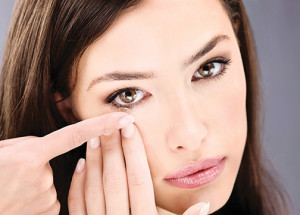Choosing Contact Lenses
In today’s ever-changing world just about anyone can wear contact lenses. And there are more options than ever before. If you don’t wear contacts and want to, you must first see an ophthalmologist, or an optometrist. Even if you don’t wear glasses and just feel the need to change your eye color, you must be examined first.
In the United States, contact lenses may only be legally purchased with a valid written prescription. Contacts are medical devices that have to be properly fitted and prescribed just like prescription medicines.
Your eye care professional will check your eyes and make sure you are able to wear contacts. While most people can wear contacts, there are a few exceptions. Once it is determined that you are able to wear contacts, Dr. Bunin and her staff will determine your prescription and help you to decide which type of contact lenses will best suit your needs and give you the best possible vision.
Types of Contact Lenses
[unordered_list style=’circle’]
- Disposable contact lenses: Now the most common type of contact lens. Disposables are designed to be worn for a specific length of time usually on a weekly or bi-weekly basis and then thrown out and replaced with a new pair of lenses. Daily disposables are also available which eliminate the need for contact lens solution.
- Frequent replacement lenses: Replaced monthly or quarterly.
- Traditional lenses: Reusable and replaced every 6-12 months.
[/unordered_list]
Most eye care professionals prefer disposable contact lenses because they are considered safer than conventional lenses for two reasons. First, there is less risk of a serious eye infection with disposable contacts. Bacteria and fungi can invade a contact lens and then infect the eye. The risk increases with the age of the contact lens. And secondly, having a fresh lens available if a lens gets chipped or scratched prevents corneal scrapes and infections.
Bifocal Contacts
Bifocal contact lenses are available in newer, better, soft contact lens material. Many patients who tried bifocal contact lenses unsuccessfully in the past can successfully wear the newer lenses today. Alternatively, people who need bifocals can be fit with monovision lenses where one contact lens is fitted for distance viewing, and the other lens is fitted for near vision. Many patients easily adapt to this option.
Contact with Dry Eyes
If your eyes are very dry you may need extra lubrication to wear contacts comfortably. Dr. Bunin is an expert on dry eyes and can help you to improve the quality and quantity of tears in your eyes.
At Dr. Bunin’s office a thorough examination will be given and care will be taken in determining your prescription and what type of contact lens is best for you. Your wearing schedule and type of lens depends more on your eyes than with the lens itself. Some people’s eyes produce more protein than others and they may need to change their lenses more frequently. People with allergies may need to change their lenses more frequently during peak allergy seasons. You may need a special cleanser or a different lens material to suit your eyes.
Whatever your needs or situation, Dr. Bunin and her staff will give you the attention and answers you deserve.

